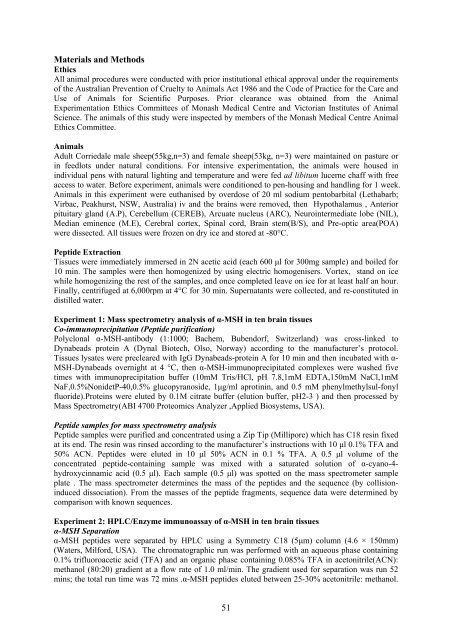Workshop proceeding - final.pdf - Faculty of Information and ...
Workshop proceeding - final.pdf - Faculty of Information and ...
Workshop proceeding - final.pdf - Faculty of Information and ...
Create successful ePaper yourself
Turn your PDF publications into a flip-book with our unique Google optimized e-Paper software.
Materials <strong>and</strong> Methods<br />
Ethics<br />
All animal procedures were conducted with prior institutional ethical approval under the requirements<br />
<strong>of</strong> the Australian Prevention <strong>of</strong> Cruelty to Animals Act 1986 <strong>and</strong> the Code <strong>of</strong> Practice for the Care <strong>and</strong><br />
Use <strong>of</strong> Animals for Scientific Purposes. Prior clearance was obtained from the Animal<br />
Experimentation Ethics Committees <strong>of</strong> Monash Medical Centre <strong>and</strong> Victorian Institutes <strong>of</strong> Animal<br />
Science. The animals <strong>of</strong> this study were inspected by members <strong>of</strong> the Monash Medical Centre Animal<br />
Ethics Committee.<br />
Animals<br />
Adult Corriedale male sheep(55kg,n=3) <strong>and</strong> female sheep(53kg, n=3) were maintained on pasture or<br />
in feedlots under natural conditions. For intensive experimentation, the animals were housed in<br />
individual pens with natural lighting <strong>and</strong> temperature <strong>and</strong> were fed ad libitum lucerne chaff with free<br />
access to water. Before experiment, animals were conditioned to pen-housing <strong>and</strong> h<strong>and</strong>ling for 1 week.<br />
Animals in this experiment were euthanised by overdose <strong>of</strong> 20 ml sodium pentobarbital (Lethabarb;<br />
Virbac, Peakhurst, NSW, Australia) iv <strong>and</strong> the brains were removed, then Hypothalamus , Anterior<br />
pituitary gl<strong>and</strong> (A.P), Cerebellum (CEREB), Arcuate nucleus (ARC), Neurointermediate lobe (NIL),<br />
Median eminence (M.E), Cerebral cortex, Spinal cord, Brain stem(B/S), <strong>and</strong> Pre-optic area(POA)<br />
were dissected. All tissues were frozen on dry ice <strong>and</strong> stored at -80°C.<br />
Peptide Extraction<br />
Tissues were immediately immersed in 2N acetic acid (each 600 μl for 300mg sample) <strong>and</strong> boiled for<br />
10 min. The samples were then homogenized by using electric homogenisers. Vortex, st<strong>and</strong> on ice<br />
while homogenizing the rest <strong>of</strong> the samples, <strong>and</strong> once completed leave on ice for at least half an hour.<br />
Finally, centrifuged at 6,000rpm at 4°C for 30 min. Supernatants were collected, <strong>and</strong> re-constituted in<br />
distilled water.<br />
Experiment 1: Mass spectrometry analysis <strong>of</strong> α-MSH in ten brain tissues<br />
Co-immunoprecipitation (Peptide purification)<br />
Polyclonal α-MSH-antibody (1:1000; Bachem, Bubendorf, Switzerl<strong>and</strong>) was cross-linked to<br />
Dynabeads protein A (Dynal Biotech, Olso, Norway) according to the manufacturer’s protocol.<br />
Tissues lysates were precleared with IgG Dynabeads-protein A for 10 min <strong>and</strong> then incubated with α-<br />
MSH-Dynabeads overnight at 4 °C, then α-MSH-immunoprecipitated complexes were washed five<br />
times with immunoprecipitation buffer (10mM Tris/HCl, pH 7.8,1mM EDTA,150mM NaCl,1mM<br />
NaF,0.5%NonidetP-40,0.5% glucopyranoside, 1μg/ml aprotinin, <strong>and</strong> 0.5 mM phenylmethylsul-fonyl<br />
fluoride).Proteins were eluted by 0.1M citrate buffer (elution buffer, pH2-3 ) <strong>and</strong> then processed by<br />
Mass Spectrometry(ABI 4700 Proteomics Analyzer ,Applied Biosystems, USA).<br />
Peptide samples for mass spectrometry analysis<br />
Peptide samples were purified <strong>and</strong> concentrated using a Zip Tip (Millipore) which has C18 resin fixed<br />
at its end. The resin was rinsed according to the manufacturer’s instructions with 10 μl 0.1% TFA <strong>and</strong><br />
50% ACN. Peptides were eluted in 10 μl 50% ACN in 0.1 % TFA. A 0.5 μl volume <strong>of</strong> the<br />
concentrated peptide-containing sample was mixed with a saturated solution <strong>of</strong> α-cyano-4-<br />
hydroxycinnamic acid (0.5 μl). Each sample (0.5 μl) was spotted on the mass spectrometer sample<br />
plate . The mass spectrometer determines the mass <strong>of</strong> the peptides <strong>and</strong> the sequence (by collisioninduced<br />
dissociation). From the masses <strong>of</strong> the peptide fragments, sequence data were determined by<br />
comparison with known sequences.<br />
Experiment 2: HPLC/Enzyme immunoassay <strong>of</strong> α-MSH in ten brain tissues<br />
α-MSH Separation<br />
α-MSH peptides were separated by HPLC using a Symmetry C18 (5μm) column (4.6 × 150mm)<br />
(Waters, Milford, USA). The chromatographic run was performed with an aqueous phase containing<br />
0.1% trifluoroacetic acid (TFA) <strong>and</strong> an organic phase containing 0.085% TFA in acetonitrile(ACN):<br />
methanol (80:20) gradient at a flow rate <strong>of</strong> 1.0 ml/min. The gradient used for separation was run 52<br />
mins; the total run time was 72 mins .α-MSH peptides eluted between 25-30% acetonitrile: methanol.<br />
51
















